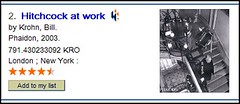I like sneaking in new OPAC bits when no-one’s looking and then waiting for people to discover them 🙂
Before Christmas, I was chatting to Kathryn Greenhill in Second Life about OPAC-y (or should it be “OPACeous?”) things, and I turned a vile of green when I discovered that she’s got user ratings on their OPAC at Murdoch University.
I should point out that’s “green” as in “envy” rather than as in “driving the porcelain bus“! Having said that, I like to think there might be at least a couple of ultra-conservative librarians out there somewhere who do get nauseous whenever they see Web/Library 2.0 stuff creeping into that nasty online card catalogue… just like Maggie might do in “Little Britain”:

Anyway, half an hour of frenetic mod_perl and MySQL activity later and we’ve now got something similar on our OPAC:


I’d like to add the facility for user comments/reviews too, but for the moment I’m happy just take a few baby steps with user ratings.
12 thoughts on “Baby steps”
Comments are closed.
Super!
With coding skills that can knock up this type of thing, you need never be green again. When I see shiny toys I just sigh and lust instead. Baby steps for you..flying near the impossible for the rest of us.
On the other kind of green…we mopped up the green goop when we took the card catalogue out of the building…and we’ll mop it up again as we make the OPAC Really Useful. (And what’s more, we’ll giggle as we do it )
I love it! When I read the description, I imagined that you’d have to be logged in to rate items. That would not only prevent multiple voting, it would also allow people to keep track of what they’d voted on already, and what they liked — and perhaps enable a later module that would do some complicated maths to say “Other people who share your high opinion of Vertigo and Rowboat also liked The Birds”.
But you’ve gotta leave SOMETHING for the next version, eh wot?
I did think about that and I wondered how much of a barrier it would be to make people log in first. The HIP session number also gets logged with the rating, so it would be possible to ignore multiple votes cast for the same item in the same session.
I also wondered how many non-Huddersfield ratings we might get (“drive by ratings”?) — we’ve already had a couple of ratings added by people in the US.
If we start getting regular ratings, then I’m planning to add a “recent ratings” list to the front page of the OPAC – e.g.:
https://library.hud.ac.uk/perl/recentratings.pl
I like your idea of suggestions based on ratings!
I’ve been toying with suggestions based on items previously borrowed, but need to do a little more testing — my library account is regularly used for testing, so there’s dozens of weird book titles in my history and that (in turn) gives weird suggestions!
Why are you soliciting ratings of 1, 2, 3, 4, 5, 6, 7, 8, 9, or 10 (without stars), and showing them as 0, 0.5, 1, 1.5, 2, 2.5, 3, 3.5, 4, 4.5, and 5 stars? Seems like it’d be better to just allow ratings of 1, 2, 3, 4, or 5 stars, and then use fractional stars to show an average.
Ooh, ooh, ooh! You could have a graphic with stars filled up with ‘transparent’ color, and use CSS to superimpose that over a CSS-generated bar graph (http://applestooranges.com/blog/post/css-for-bar-graphs/) to allow a finer range of star averages.
I’m not sure what that adds to the users’ actual experience, or takes away from accessibility, but we ARE talking about Web 2.0 here, so who cares? As long as it’s shiny…
Heh – to be honest, ever since Iman introduced me to sparklines I’ve been looking for a way of incorporating them into the OPAC 😉
I’m going to steal your suggestion of changing to stars, although I also like the idea of adding “11” to the list of options 😀
How about adding “ratings” as a field for the “sort by” option ?
Sadly that’s beyond my limits 🙁
This is merely “lipstick on a pig” — I’d need to operate on the pig and rearrange some of it’s internal organs to add ratings to the sort options!
not the best place to ask this but
what are you using to get the cover scans in HIP? it does not appear to be Syndetics or Content Cafe
Hi Greg
We use the Amazon Web Services and cache the images locally for 24 hours.
Can I ask what the ratings system is for? Does the data that you gather from it feed into some sort of relevance ranking algorithm? Or some other purpose?